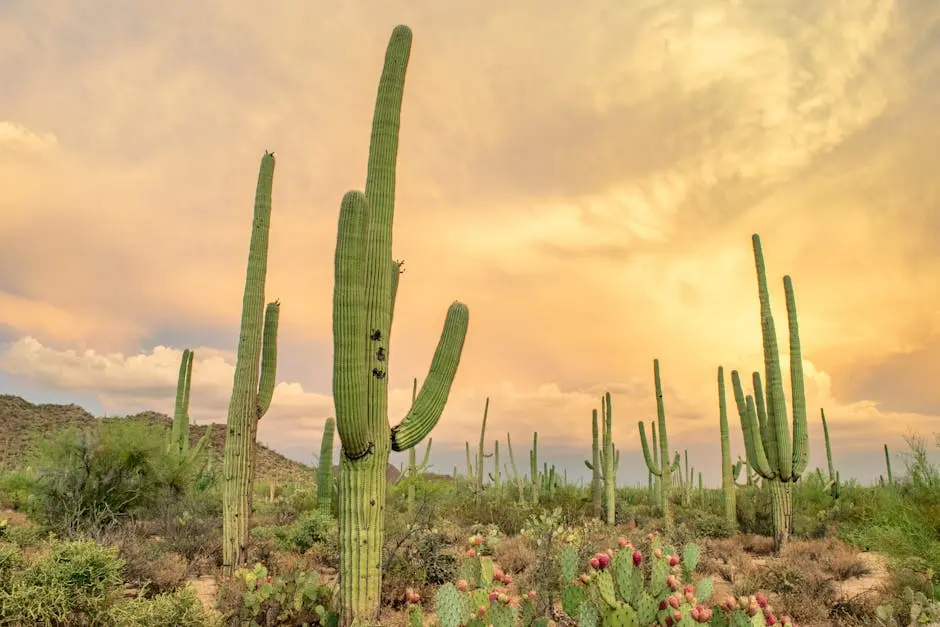Nestled in the heart of the Sonoran Desert, Saguaro National Park offers a stunning landscape teeming with natural beauty and unique flora and fauna. Whether you’re an avid hiker, a wildlife enthusiast, or someone who simply appreciates the allure of nature, this park is sure to captivate your senses. In this blog, we’ll explore the wonders of Saguaro National Park, delving into its diverse ecosystems, rich history, and the captivating giants that call it home.
The Majestic Saguaro: The Icon of the Desert
The saguaro cactus, native to the Sonoran Desert, stands as a symbol of the American West. These majestic giants can grow over 40 feet tall and live for more than 150 years. In this section, we’ll delve into the life cycle of the saguaro cactus, exploring its adaptations to the harsh desert environment and its vital role in the ecosystem.
A visit to Saguaro National Park unveils the fascinating life of the saguaro cactus, from the tiny black seeds that emerge from fruit with a raspberry-like flavor to the iconic arms that stretch skyward. The saguaro’s anatomy is nothing short of a marvel of nature—its thick waxy skin, which helps retain precious water, and the accordion-like ribbed structure, which expands during rare desert rains, are adaptations that enable it to survive in a place where annual rainfall is sparse. Learning about how the saguaro interacts symbiotically with the desert’s inhabitants, providing homes for birds like the Gila woodpecker and elf owl, offers insight into the delicate balance of this arid ecosystem.
The saguaro is not just another plant—it is a keystone species crucial for the survival of numerous desert creatures. The flowers that bloom atop its towering stalks provide nectar for migrating bats. As each blossom falls to the ground, it heralds the arrival of the saguaros’ distinctive red fruit, a staple for the Tohono O’odham people traditionally harvested using long poles. Understanding its deep roots in both geography and culture helps frame the saguaro’s standing as a revered figure in desert lore.
Diverse Flora and Fauna: A Biodiversity Hotspot
Beyond the iconic saguaros, Saguaro National Park is home to a wide array of plant and animal species. From blooming wildflowers to elusive bobcats, this part of the Sonoran Desert is bursting with life. Discover the rich biodiversity that defines this national park and learn about the unique adaptations that enable its inhabitants to thrive.
Saguaro National Park is a sanctuary for botanists and wildlife enthusiasts alike. With over 25 unique species of cacti such as the prickly pear, cholla, and barrel cactus, every turn on the trail can unveil a new spectrum of life. During spring, the desert erupts into a colorful tapestry of wildflowers, which draw species like the desert tortoise and the vibrant Sonoran hummingbird. The park is also home to a rich assortment of mammals, including the stealthy javelinas and coyotes whose calls echo hauntingly through the canyons at dusk.
The magic of Saguaro National Park lies in its subtlety. Observation and patience reveal darting lizards basking in the sunlight, and keen eyes might catch a glimpse of the elusive bobcat wandering through more secluded areas. Bird watchers will find the park especially rewarding, with over 200 species of birds making this desert their home. From the flash of a red-tailed hawk soaring above to the gentle woodpecking of the gilded flicker, myriad avian wonders await.
Exploring the Park: Trails and Adventure
Saguaro National Park offers an array of trails for adventurers of all skill levels. Whether you’re seeking a leisurely stroll or a challenging hike, there’s a path for everyone. We’ll guide you through some of the most popular trails, pointing out what you’ll encounter along the way, and provide tips to make the most of your visit.
Among the park’s extensive network of trails, the Desert Ecology Trail offers an introduction suited for families, with interpretive signs that share interesting facts about the native plants and animals. For the seasoned hiker, the trek up Wasson Peak in the Tucson Mountain District provides challenging terrain and rewarding, expansive views once you reach the summit. This trail passes through the heart of a dense saguaro forest, offering awe-inspiring encounters with these giants.
For breathtaking vistas and a chance to observe the park’s diverse wildlife, the Javelina Rock Trail doesn’t disappoint. As a less-traveled trail, it provides an intimate experience with the environment, perfect for those seeking solitude amid scenic beauty. Remember to carry ample water, wear sturdy hiking shoes, and apply sun protection as you explore the park’s remarkable landscapes.
If cycling is more to your liking, the Cactus Forest Loop Drive is a paved path in the East District perfect for cycling enthusiasts and smooth drives. Bikers and motorists alike are treated to panoramic views of the surrounding desert landscape, making this a favored route for photographers capturing postcard-quality images of the sunrise or sunset. However you choose to travel, each trail and viewpoint offers its own unique slice of the park’s majestic beauty.
The Rich Cultural History of Saguaro National Park
This national park is steeped in history, with traces of ancient civilizations and pioneer settlers. From native peoples who revered the land to the ranchers and miners who traversed the desert, each has left an indelible mark. Join us as we explore the cultural tapestry that adds depth to the park’s natural charm.
Saguaro National Park is more than a natural sanctuary; it’s a living testament to the region’s vibrant cultural heritage. Long before modern adventurers roamed the trails, the Tohono O’odham people flourished here, crafting an enduring bond with the desert environment. Their intimate understanding of the land and its rhythms allowed them to thrive, guided by the seasonal bounty of the saguaro harvest, which remains a vital cultural tradition today.
The park’s story is also intertwined with the tales of European settlers who ventured into the arid expanse seeking new beginnings. Traces of their passage linger within the ruins dotting the landscape. Equally powerful is the legacy of ranchers who forged a hard-won existence on the desert’s harsh terms. Visiting Signal Hill, where ancient petroglyphs etched into rock faces reveal a glimpse of the narratives that shaped the region, creates a tangible connection to those who preceded us.
Even today, Saguaro National Park remains a locus of ongoing conservation efforts. Its designation as a National Park reflects a commitment to preserving this unique environment and honoring the deep-seated histories of those who called the Sonoran Desert home. As one traverses the trails or pauses in the shade of a centuries-old mesquite tree, the layers of the past come alive, inviting us to celebrate the enduring spirit and strength of this extraordinary land.
Best Times to Visit and Practical Tips
Planning a trip to Saguaro National Park requires careful consideration of weather and seasonal changes. Here, we’ll share the best times to visit, what to pack, and tips for staying safe in the desert environment. Proper preparation will ensure a memorable and enjoyable experience in this breathtaking park.
The optimal time to explore Saguaro National Park is during the cooler months, from October to April. This period offers mild temperatures perfect for hiking and exploring without the extreme heat that can dominate the summer months. Visiting during this time also coincides with the park’s blossoming wildflowers in March and April, a display that transforms the desert into a vibrant mosaic of color.
To ensure a comfortable visit, prepare by dressing in layers to adjust to fluctuating temperatures and bring a wide-brimmed hat and sunglasses for sun protection. Ample water and snacks are essential, as well as a reliable map, since cell service can be inconsistent within the park. For those keen on backcountry exploration, it’s wise to inform someone of your planned route and expected return time.
If visiting in summer, early morning or late afternoon excursions provide respite from the heat, and the sight of a desert sunset is well worth the wait. Nighttime reveals another dimension of beauty at Saguaro National Park, designated an International Dark Sky Park, where celestial displays are extraordinary. With these tips and a spirit of adventure, your journey through Saguaro National Park is sure to be unforgettable.
Embrace the Desert’s Splendor
Saguaro National Park is more than just a natural wonder; it’s a testament to the profound beauty and resilience of the desert landscape. From the towering saguaros to the vibrant wildlife and the serene trails, this park offers something for everyone. Whether you’re planning your first visit or returning for another adventure, Saguaro National Park is a nature lover’s haven that will leave a lasting impression. So pack your bags, lace up your hiking boots, and experience the enchanting beauty of this remarkable destination. Visit Solana Spanish Villas to explore luxurious accommodations near the park’s stunning scenery.



0 Comment